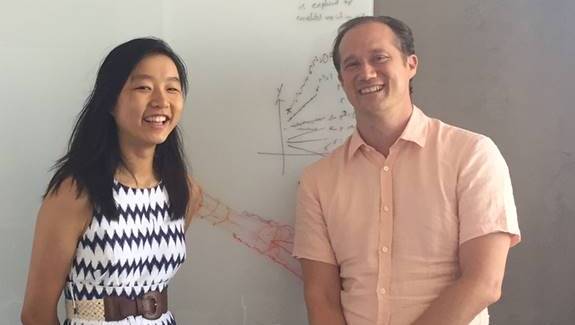by Jocelyn Shen, EXPLORE Alumna
As an intern at the UCLA Department of Biomathematics for the past two summers, I have developed as a researcher, as well as a person, under the mentorship of Dr. Van Savage. Two years ago, when I first started the EXPLORE program, I had no idea what biomathematics was. All I knew was that it sounded fun and I was excited to learn more. Dr. Savage shared my same enthusiasm about what I was learning and was extremely involved, sharing papers, presentations, and websites – anything that would help me become a better researcher. He gave me opportunities to work with other talented students and postdoctorates, whom I learned a great deal from.
My first year work involved comparing two versions of vessel extraction software, Angicart and Angicart++, and studying the theory behind scaling properties of blood vessel networks. I ran 3D angiographic image data through software to output blood vessel properties. I also taught myself MATLAB and developed code that I used to study the outputted properties and calculate scaling ratios. Dr. Savage helped me through every step along the way, always available to answer questions, providing me a place to work, and making sure that I was learning and having fun.
I was incredibly excited when Dr. Savage mentioned the prospect of me coming back to work with him this past summer. I had made significant progress over the six weeks I spent working in his lab the summer before, and I was eager to continue where I left off. From my data mining and machine learning classes I took at school that year, I learned the basics of various classification methods such as decisions trees, principal component analysis, and neural networks and implemented the methods in Python. With my knowledge of machine learning tools and GitHub, I wrote a Python notebook for the project that can be shared with others. In my code, I used Python’s logistic regression functions and support vector machine functions in the scikit-learn package to study the differences between animal vasculature and plant vasculature. The functions I wrote clean datasets from the C++ vessel extraction software, then plot and analyze the data with decision boundaries. Dr. Savage and I are now working on a research paper summarizing the results of this project.
I learned from my research experience with Dr. Savage that research requires both perseverance and passion. Often, I would spend hours and hours working on a single function in the data analysis process without even knowing if the analysis was going to prove useful. This year, while working on classifying animal and plant networks, it took weeks to collect the angiographic images, generate a large enough dataset, and clean the data.
Despite how challenging and time-consuming the research was, I learned so much and truly enjoyed it. Dr. Savage helped me fully discover my passion in interdisciplinary computer science and biology research. I improved my coding skills, applied knowledge I gained in class to real data, and learned how to present my findings more effectively. These skills have helped me better communicate my ideas to other people.
Throughout the project, I constantly came up with new ideas and questions that I could ask Dr. Savage, and he further fueled my creativity and drive. Through Dr. Savage’s mentorship, I became fascinated by the way nature abides to mathematical laws and the predictive power of new computing technologies. I became eager to learn more about the interrelatedness of biology and computer science, and I developed skills that I will be using for the rest of my life.
Would you like to be connected with a professional mentor this summer? Apply for the 2018 EXPLORE program today! Applications are due by April, 16th.
Read Part 2 of the series here.
Like this post? Sign up for our email newsletter to receive more stories, information, and resources about gifted youth straight to your inbox.

